This was published 1 year ago
‘You must tell no one’: The secret Brendan’s dad wanted kept for a lifetime
He was nearly 30 when he finally tracked down his biological mother, who turned out to be a nun. Then came an even more stunning revelation.
By Brendan Watkins
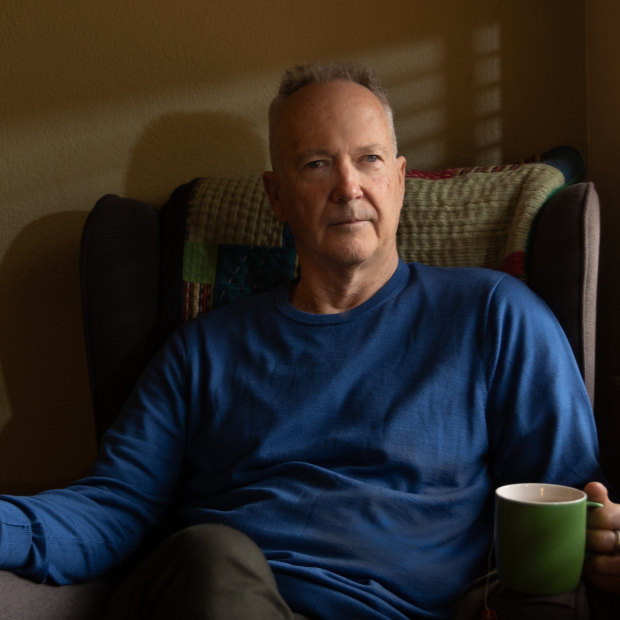
Brendan Watkins was consumed with questions after seeing his birth mother’s name: did he have siblings? Who was his father? And why couldn’t she keep him?Credit: Simon Schluter
I learnt my birth mother’s name close to 30 years after the severing of our umbilical cord. In 1990, I was sitting in the office of a counsellor from the Catholic Family Welfare Bureau in Melbourne. It was cold in the room. A box of tissues had been placed on the table next to where I sat.
After brief introductions, the counsellor unceremoniously handed me my original birth certificate. As my hands shook with adrenaline, I could only focus on two unfamiliar words printed on the certificate. I slowly scanned each letter: M a g g i e B e c k e r.
The certificate showed that Maggie had been born in South Australia and was 27 when she gave birth. That made her much older than most mothers who’d put their children up for adoption.
And my birth father? There was an empty box on the form that should have contained his name. The counsellor, an abrupt woman named Jenny Abbott*, told me it was common for the father’s name to be missing from birth records. And there was more: Maggie had actually named me. Paul Becker. A solitary bon voyage gift. Learning this name, Paul Becker, was the beginning of a second identity that I would pursue for the next 30 years.
I wasn’t told if my mother held me after I was born. I wasn’t told how much I weighed or what time I was born. I didn’t learn how long Maggie’s labour was or if mine was an arduous birth. Closed adoptions were shrouded in layers of secrets. I knew many adoptees received at least some of these answers in meetings like these.
I had no inkling of it at the time, but I later discovered I was being treated very differently from everyone else. Jenny and I discussed my desire for contact for some time; reluctantly, she concluded, “Well, all right – if that’s your wish – the best way forward is to have me make contact on your behalf.” I felt I had no choice, that this was my only option.
In those days, the influence of the Catholic Church was everywhere to be seen, at least in the world I lived in: crusty clerics were forever pontificating about how we should live our lives, sour-faced old men defending the status quo. And Jenny, of course, was a senior agent of the Church, a position that gave her a tangible moral authority. The unmistakable message from Jenny was to let sleeping dogs lie. The unsaid instruction was to bury my emotions.
Despite Jenny’s urging, I told her I wanted her to call this Maggie Becker straight away and tell her that her son wanted to talk. I had so many questions, too: do I have brothers and sisters? Who is my father? What were the circumstances of my birth? Why couldn’t she keep me?
I left Jenny’s office and returned home to brood. At night, before drifting off to sleep, I would fabricate fabulous fantasies of family reunions with my forebears, wonky-eyed like me. And sometimes, well before the dawn, I woke with stomach-churning nightmares of rejection.
After several weeks, Jenny called and asked me to meet her again. But the moment I entered her office and noted her demeanour – unnervingly grim – I knew the news wasn’t going to be good. Without fanfare, Jenny announced that she’d spoken with my mother. My heart skipped – she’s alive! I was told my request for contact was stressful for Maggie. She’d spent her entire life believing communication with me would never occur.
Intentionally or not, Jenny’s disapproving tone and expression made me feel like what I wanted – contact with my mother – was selfish. My mind accelerated into overdrive. I knew she might have been left high and dry by my father, and that a black hole of guilt was likely to have accompanied the decision to relinquish me. Assuming she was a believer, the Church would have added its own layer of existential angst to the storm – hell and damnation awaited the mothers of the illegitimate.
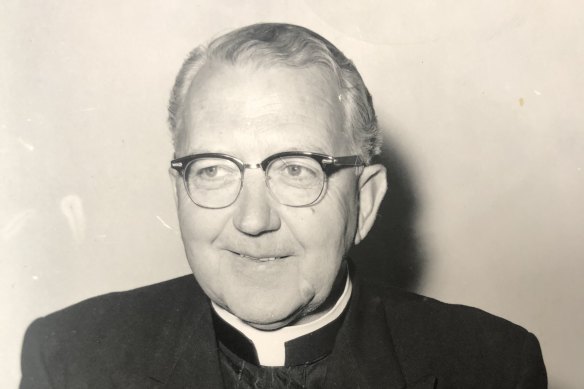
Father Vincent Shiel, pictured in the 1960s, was described as “a great dancer … a charmer”.
“Maggie Becker is in Sydney,” Jenny said, “where she’s lived all of her adult life.”
“Terrific,” I replied. “What’d she say?”
“Brendan, she has told me she can’t ever meet you. There will be no contact.“
The words pinged in my head. She can’t ever. No contact. “Maggie is a very intelligent, determined and devout woman,” Jenny continued. “It’s not that she doesn’t love you – in fact, she prays for you every day …”
If this addendum was intended to soften the blow, it failed.
“… but there will be no communication with Maggie.”
I couldn’t gather my thoughts. How could I be rejected a second time? Jenny’s next instruction scythed into my core: “You need to go home and forget about Maggie Becker forever.”
After a pause, she said, “In my experience, determined mothers who don’t want contact never change their minds.”
My brain became white noise. Discarded, I trudged home to my girlfriend Kate, unaware that a match had been struck, igniting an anxiety that would smoulder within me for decades.
Over the coming days, Kate and I pondered possible explanations. Maybe Maggie was married and her husband didn’t know about me? Or was there a traumatic secret she was protecting me from? But if that was the case, what was it? Maybe I was the result of rape or incest. Is there anything worse?
Whatever the truth, it now seemed that I was shame personified. My appetite vanished; I slept poorly. Like a dog hit by a car, I lay low. Months passed.
I’d been driven by a certainty that knowing my ancestry would make me whole, and I just couldn’t let go of the idea of meeting my birth mother. I decided to make contact. I knew it could go horribly wrong, but she hadn’t shared a single thing, not even basic health information. It was unjust; we knew everything about our cocker spaniel’s pedigree, but nothing about mine.
I wrestled with my conscience, though. What right did I have to stick my nose in when the almighty Catholic Family Welfare Bureau had warned me to
stay away?
Over the next six months, Brendan sent two letters to Maggie, which met with no response, and a third to a different address in a beachside suburb of Sydney.
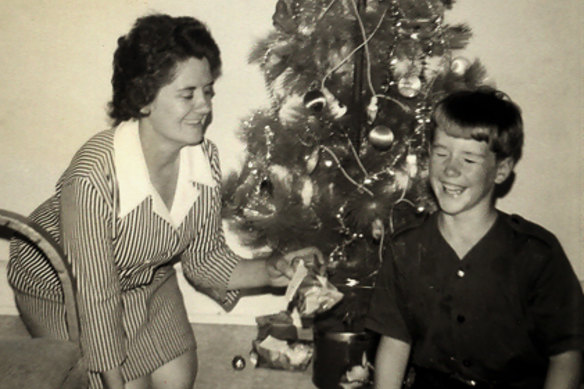
Brendan with his adoptive mum Betty Watkins at Christmas in the 1970s.Credit: Courtesy of the Shiel, Meaney & Watkins families
Two weeks later, I received an envelope with “M. Becker” written on the back in a tight and efficient script. I tore it open and saw a full page of my birth mother’s handwriting for the first time. Maggie had a steady hand, with understated flourishes. I took a deep breath and sat down to read.
Maggie’s letter was to the point. She said she was happy to hear that I was well-adjusted and healthy, and she acknowledged that, while stressful for her, I had a right to some information about the circumstances of my birth. Maggie told me she had been in a serious relationship with a man in Sydney but then had been abandoned by him when she became pregnant. To avoid the judgment of society, she had come to Melbourne to have me by herself and then put me up for adoption, because she thought it would be for the best. She still believed that she’d done the right thing, but asked my forgiveness for any hurt that decision may have caused me.
Maggie said that she and I would never have a face-to-face meeting. This was not a rejection, she added, but a result of the secret she and I shared. She said she loved me. But she still wanted nothing to do with me.
I called Jenny Abbott, but her response was icy. She advised that there was no further information she could give me and firmly instructed me to curb my enthusiasm. (Many years later, a church insider told me that the Catholic Family Welfare Bureau saw its role at the time as protecting relinquishing mothers from their surrendered children.) While it wasn’t the response I wanted, at least I had Maggie’s letter. This was the closest I’d been to someone who shared my DNA. It was evidence that I had ancestors, and they were within reach.
After stewing over matters for weeks, I decided I wasn’t compelled to follow Jenny’s orders. With the help of adoption search agency Jigsaw, I established that Maggie was from a large family in Port Augusta in South Australia. Some of her brothers and sisters were alive and had children of their own. A brother, Barry, ran a building business in South Australia.
Jigsaw’s advice was to have a less emotionally invested person make first contact, so I asked Kate to make the call. We agreed that we had little choice but to fabricate a story. Kate would say she was an old friend of Maggie Becker’s from Sydney who’d lost contact and was trying to get back in touch. The next day, during her lunch break at work, Kate called my birth uncle’s home number and asked his wife for help.
“Yes, of course,” Barry’s wife replied. “You mean Maggie the nun?”
As soon as she hung up, Kate rang me at work.
“Are you sitting down?” My stomach dropped, blood pulsing in my ears. I still have the studio notepad page where I’d written Barry’s home phone number, Maggie’s name, and in large, bold letters: “NUN!!!”
Christ, I thought. My mother is a nun.
Maggie’s second rejection instantly became easier to comprehend. How could a nun ever tell anyone that she’d surrendered a child? A pregnant nun! It sounded like something from The Dave Allen Show. In the world I was brought up in, nuns were revered. They were also virgins.
I wrote again and enclosed a photo of Kate and me: maybe she’d see something of herself in me. “What about my father? I’d love to know more about him … Love, Brendan.”
There was no reply. It was clear I was an object of some industrial-strength shame. It appeared that my mother’s sole priority was to protect her reputation. But what about me?
In the world I was brought up in, nuns were revered. They were also virgins.
I’d hoped that by now I’d be impervious to these repeated disappointments, but it wasn’t any easier this time. The struggle for an adoptee is to convince yourself of the paradoxical notion that your parents loved you so much that they gave you away. To mourn in public is to be ungrateful; the only place for grief is within. I marinated in angst for too long, and months passed as I struggled to accept that the hunt was over. But I just couldn’t get past it.
Over the next 25 years, Brendan and Kate tried to track down his father. In 2018, with the help of ancestry.com and after a painstaking slicing and dicing of family trees, they established that he was linked to a large, Sydney-based family called Shiel; further research narrowed the field of possible fathers to four. Kate then used electoral roll data to discover several overlapping addresses for Maggie Becker and one of these men: Vincent Bede Shiel. A phone conversation with a DNA-matched cousin confirmed that Maggie and Shiel had known each other for decades and had even lived together for several years: she was his housekeeper. Vincent Shiel immediately became their number one person of interest.
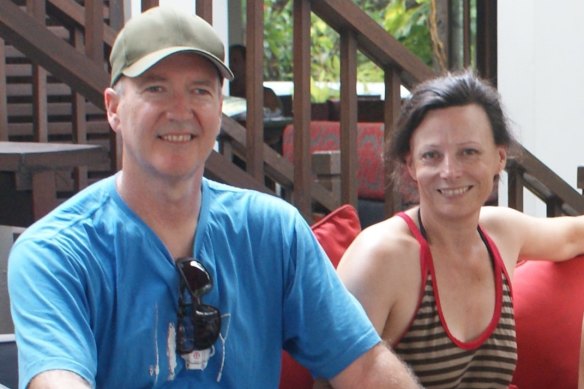
Brendan with his girlfriend Kate, who made many phone calls in an attempt to discover his birth mother’s whereabouts.Credit: Courtesy of the Shiel, Meaney & Watkins families
On July 16, 2018, Kate called Maggie, who was now 84 and living in Brisbane, and explained how I’d submitted my DNA and what we’d found. She went through the convoluted steps that led us to believe that a man we now knew she’d been close to for decades was, in fact, my birth father. But was it likely? That man had been 30 years older than her. And he had also been a Catholic priest.
As Kate talked, Maggie did not utter a word. Proceeding with care, Kate stepped through lists of the Shiel family – relatives with whom we’d just learnt Maggie had shared decades of her life.
“Maggie, Brendan is a Shiel. The DNA is irrefutable. We just need to know which Shiel. Please, Maggie, we believe that Father Vincent Shiel is Brendan’s father.”
Sitting next to Kate on our kitchen bench, I remained silent, leaning in, trying to make out the response down the line from Brisbane. How could she deny the identity of my father now?
Maggie umm-ed and ahh-ed, rolled the question around like a riddle: “Noooo … No, I don’t think Father Vincent could be Brendan’s father.” Kate left a long pause. My mother didn’t fill it.
“I understand this is hard to talk about … but please, Brendan is owed the truth. I’d prefer to not contact the other three men’s families,” Kate pleaded. Maggie evaded again. They went round in circles, but as there was no progress the call was wound up.
At work the next morning, Kate answered her mobile, and my mother finally made her confession.
Kate called me at work to relay the long-awaited truth; my journal notes record Maggie’s response. “Yes, Father Vincent Shiel is Brendan’s father. Yes, he was a priest. A good man – but long dead. The lifting of this weight is an enormous relief for me, although I am anxious Brendan will think poorly of me and be angry … but more than anything I feel so much better that this troubling secret is finally out. I’m sorry for lying to Brendan over all of these years.”
Maggie had revealed that Vincent, who had died in April 1993, aged 91, was “a kind and decent man”, though “he was older than me”. She’d known him since she was a teenager, and their friendship had endured until the day he died.
She shared some surprising details. He went to university and had been an architect before becoming a priest late in life. He designed and oversaw the building of a number of churches in the outback. He’d travelled the world. She described him as “a great dancer … a charmer”.
When she’d discovered the pregnancy, Father Vincent arranged for Maggie to travel to Melbourne and stay with a Catholic family in the months before my birth and adoption. He made her promise to keep me a secret forever: “You must tell no one.”
Maggie had stressed that the truth must remain a secret between the three of us. She reiterated that she had been raised in poverty, her family had rarely shown kindness or love, and without saying it, she was asking for mercy.
The next morning, my mother finally made her confession … “I am anxious Brendan will think poorly of me.”
Once my father was found, I’d thought I’d feel somehow complete, but it was a shuddering anticlimax. I wanted to quit my job and lie low for several weeks or months. The knowledge that my birth parents were a couple [Maggie had gone to live with Vincent after she left the convent in the 1980s until his death] and yet still chose to shun me to preserve their holy reputations was such a gut-punch. They were the worst kind of frauds: religious hypocrites. From that day on, I claimed ownership of my story. I would be my own narrator. I was 57 years old and, for the first time in my life, I knew for certain who both of my birth parents were. I exhaled as though I’d been holding my breath for years.
Nobody knows the precise number of children of priests, but surveys have suggested that about half of all Catholic priests have had sexual relationships, mostly with adults, and there are currently about 400,000 Catholic priests globally. The most extensive empirical research into priestly celibacy is a longitudinal study of 1500 Catholic priests conducted over 25 years by ex-priest Richard Sipe. His startling conclusion was that less than half of Catholic priests in the United States attempt celibacy.
Given these statistics and the Catholic view on clerical celibacy, contraception and abortion, it’s reasonable to conclude that many thousands of children have been born – and mostly abandoned – by their priest fathers. A UN Rights of the Child report from 2014 noted that “the mothers may obtain a plan for regular payment from the Church until the child is financially independent only if they sign a confidentiality agreement not to disclose any information about the child’s father or the plan”.
Michael Rezendes, the Pulitzer Prize–winning journalist from The Boston Globe’s Spotlight team (renowned for exposing systemic child sex abuse by Catholic priests), calls the children of priests “an invisible legion of secrecy and neglect”. A National Catholic Reporter article on August 21, 2017, stated that “Depression, suicidal thoughts, excessive drinking and ritual cutting habits have all been a part of the residue of being the child of a priest” and that many of these children struggle with lifelong familial secrecy, suffer a crisis of identity and faith, and have often been brought up in financially deprived situations.
My research made for awful reading. I already knew that the Catholic Church’s standard response to reports of priest child abuse had been to move the priest to a new parish; it seemed its response to a priest fathering a child was the same. What followed was permanent estrangement of child and father.
The fate of the mother often seemed to be considered not worth reporting. She was left holding both the infant and the secret of paternity. While some women had abortions (sometimes at the priest’s behest), most appear to have surrendered their child for adoption or placement in a foster home. The paternity of children who did remain with their mothers was always shrouded in lies and half-truths. Overwhelmingly, the mothers blamed themselves. Religion, sexual taboo and the authority of the priest insidiously shifted the guilt onto the woman.
What was painfully obvious was that most children of priests had battled a diverse range of silencing behaviours from the Church, their birth mothers, Catholic adoption agencies and often, by association, their wider communities.
David Weber, the founder of the Frankfurt-based organisation Human Rights for Children of Priests, explained in an article in L’uomo Vogue, “Orphans of God”, how the church views priests’ children “as a threat to its authority, and therefore nothing less than an enemy”. Hence, he says, “the need to conceal the father’s true identity at all costs, severing, when possible, his ties with the child and parents – a crime”.
Weber adds: “Highly problematic, also, is having to deal with a mother who lies about your father’s identity or, even worse, asks you not to reveal it to anyone – an inhuman pressure that shapes a whole life. Not surprisingly, many of the priests’ children I know have developed chronic diseases, often of psychosomatic origin. Even as adults, the sense of fear is so ingrained in them that they often hide being a child of a priest even to their closest friends.
Through research and social media communities I was also led to other children of priests. In one-on-one conversations, I was honoured to be told many painful secrets by complete strangers, sometimes secrets never shared with their own families. In turn, I shared my own intimate secrets – talking lightened the load.
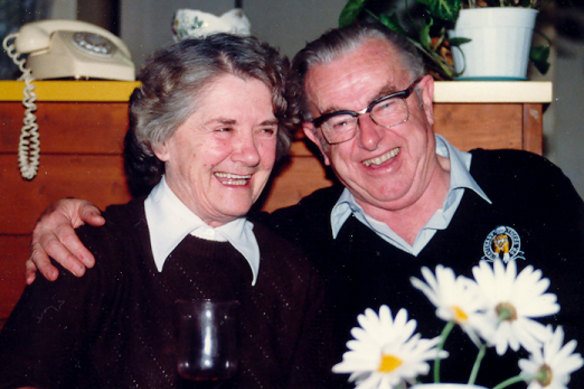
Betty and Roy Watkins, Brendan’s adoptive parents. “I was saved by the kindness of strangers,” he says.Credit: Courtesy of the Shiel, Meaney & Watkins families
I was surprised to learn only a few had been adopted, like me. Some had been raised in orphanages or foster care. A number had been raised by their birth mother, usually without a father-figure. For those, often it was a DNA test that revealed that their priest uncle, guardian or godfather (who sometimes visited) was, in fact, their father. Some had been raised by grandparents and told that they were the parents of the child. In one instance, the child had lived their whole life believing that their mother was their elder sister. More than one had been baptised by their priest father, usually only discovering the truth after his death. Some had ended up in the Catholic foster system, or orphanages, where they were raped by clergy.
Most, like me, had never met their father. One had been offered cash to keep the man’s identity secret. The common denominator was deception. Virtually everyone had lived much, or most, of their lives in the shadow of lies told by parents, family, church and community. These lies in some instances were also told by legal practitioners, hospital staff and adoption agencies. I discovered that the knee-jerk inclination of the children of priests on learning the truth was to hide it.
Shame is sticky. Shame is contagious, and if you are the embodiment of your mother’s greatest shame you must be hidden. If you are the result of rape, incest or a relationship with a priest, you are the secret. This is ancestral trauma.
Maggie’s scenario was typical. When I was conceived, she was 27 and my father 57. She was poor, uneducated and had been a member of Vin’s congregation. In her eyes, my father was literally the hands of God. I began an ongoing dialogue with Queensland academic Dr Stephen de Weger, a specialist in clergy sexual misconduct against adults. His research confirmed much of what I was piecing together from the anecdotal, that priests took advantage of both vulnerable adult women and men. He found that those who became involved with a priest were often dealing with a marital or wider family crisis, or were seeking spiritual or emotional guidance. Some were disabled, others bereaved, isolated, unwell or poor. This insidious nexus of the spiritual and sexual, whereby a priest uses his religious authority as a grooming strategy, goes to the heart of the issue. Power imbalances and the vulnerability of the woman are disturbingly common within these scenarios.
Though my own faith had long lapsed, I realised that I still behaved like a member of the Church that formed me. Taught by experts, I’d evaded making public the truth about who I really was. Years of my life had been interrupted as I searched for answers. Trauma is a thief of time. There is also the often unacknowledged “opportunity cost” of life prospects not pursued. That is a price Maggie and I have both paid, my mother by far the most dearly.
But in the final reckoning, my story is one of love. I was saved by the kindness of strangers. While the largest religious institutions in the world, professing compassion and charity to all, callously annulled my heritage, it was Roy and Bet Watkins, my adoptive parents, people with whom I shared not a drop of blood, who rescued me.
* Name has been changed.
This is an edited extract from Tell No One: A Memoir, by Brendan Watkins (Allen & Unwin; $35), out August 8.
To read more from Good Weekend magazine, visit our page at The Sydney Morning Herald, The Age and Brisbane Times.